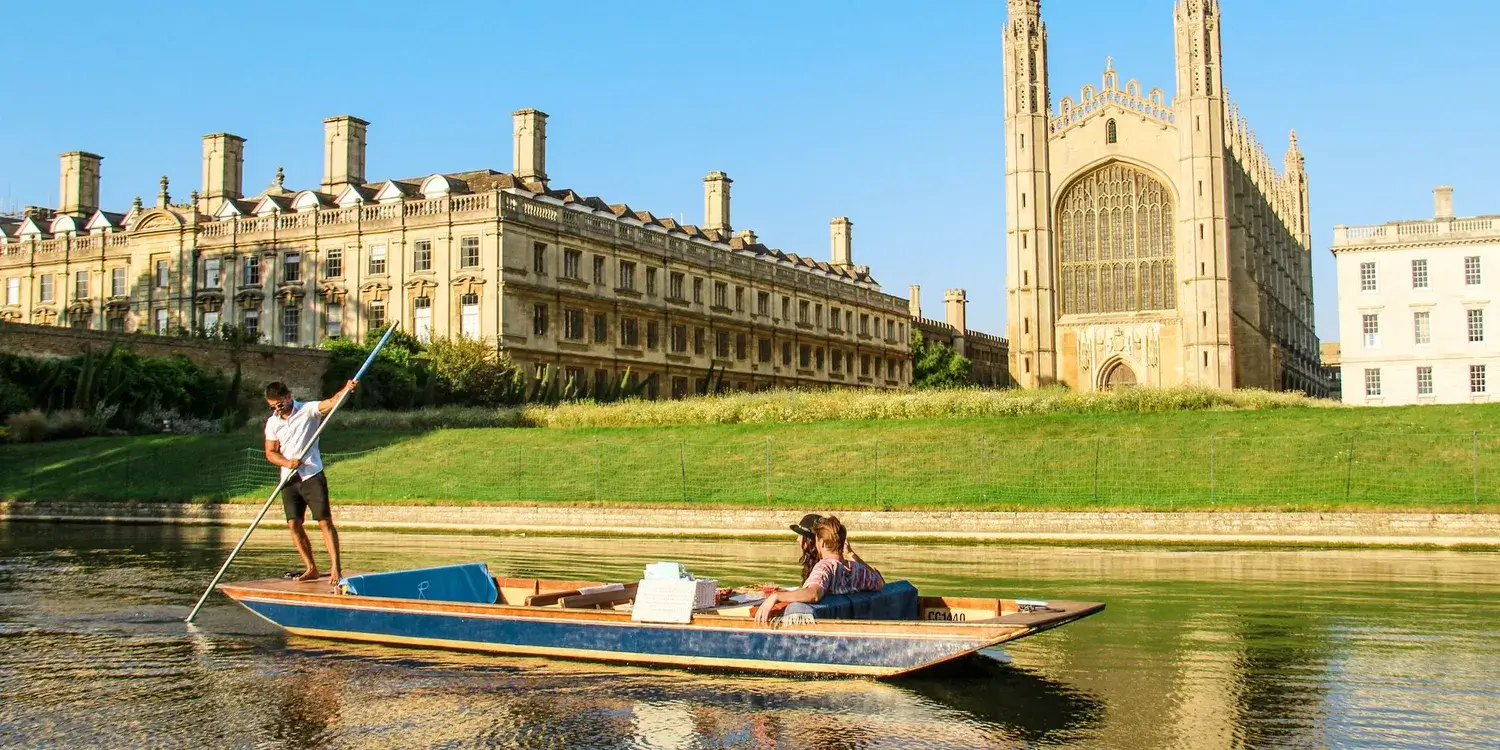King’s College Chapel

Punting Sights – King’s College Chapel
The most famous building in Cambridge; the King’s College Chapel is an iconic emblem of both the University and the city.
The foundations for the Chapel were laid on the feast of St James, 25 July 1446, with the first stone being placed by the King himself, five years after the creation of the College.
Henry had personally overseen the late perpendicular gothic architectural design of the Chapel and had planned an identical one at his boys’ school, Eton.
The original design for the Chapel would’ve seen a building four times the size of the eventual construction and it was intended to be built entirely from a white magnesium limestone mined from the King’s quarries in Tadcaster, Yorkshire.
However, the 15th Century was a tumultuous time in England and particularly in Cambridge. The War of the Roses began just months after the construction of the Chapel started.
Even so, building on the Chapel continued mostly unabated for 11 years until 1461 when Henry was captured by the Yorkist forces. The story goes that on hearing the news the workmen in the Chapel packed up and went home.
Legend has it that a half-cut stone lay where they left it until eventually it was used as a foundation stone for the neighbouring Gibb’s building in 1724.
Very little building took place over the next 22 years, as the throne passed to Edward IV. However, in 1483 Richard of Gloucester, Richard III (leader of the House of York) took the throne and things started looking up for King’s College and its Chapel.
Over the next two years, Richard pushed the building forward and thanks to his generosity and determination a creation that could’ve been abandoned were significantly advanced. But, kings didn’t last long during this period of history and in 1485 Richard III was defeated and killed at the Battle of Bosworth by Henry VII (the nephew of Henry VI).
Henry VII’s mother, Lady Margaret Beaufort (yes, the woman who would later found St. John’s College) saw the importance of solidifying her son’s reign by completing projects started by Henry VI, so she convinced the new king to contribute to the necessary funds to see the Chapel completed.
In 1507 Henry VII sent £500 to Cambridge in a chest which still resides inside the Chapel. Although both Henry VII and Margaret Beaufort died in 1509 the funds were now in place to finish the shell of what would later be recognized as one of the finest late medieval buildings in Europe.
All five hundred pounds of that money would be spent on its famous fan-vaulted ceiling, which is the largest of its kind in the world. That incredible ceiling took just 3 years to craft, between 1512-1515 yet is sometimes described as one of the wonders of the world.
Master masons consequently ensured that alongside the more traditional Tudor designs of crowns, roses, portcullises, fleurs-de-lys, and antelopes, the spectacular chapel is adorned with armorials showing both lithe dragons and smooth greyhounds to record the bond between the houses of Tudor and Beaufort.
Henry VIII succeeded his father and he oversaw the completion of the building, adding the screen, the woodwork inside the Chapel and most of the glazing. By the time Henry VIII died in 1547, it had been just over a hundred years after the laying of the foundation stone. The building has been accurately described as ‘a work of kings’ and is ablaze with Tudor symbolism.
King’s College Choir
The Chapel is home to the King’s College Choir and is renowned for its Festival of 9 Lessons and Carols at King’s, broadcast on Christmas Eve, via the BBC World Service to over 300 countries and listened to by millions.
The first song in the ‘9 Lessons’ is Once in Royal David City – the first verse of which is sung as a solo by a single choirboy aged between 9-11. And if you think singing to millions of people on your own would be scary, that boy only finds out he’s singing 15 seconds before he must start the solo.
According to the choirmaster, the boys get less nervous if they don’t know who is singing, but personally, we think that sounds far worse!
King’s College Evensong
Witnessing a world-class choir in practice in a prestigious location is naturally top of the Cambridge must-see lists from every editor.
During term only you can enter the Chapel at 5:15 pm to hear the world-famous King’s Chapel choir perform evensong in the awe-inspiring chapel for free!
The service starts at 5:30 pm Monday to Saturday and at 10:30 am and 3:30 pm on Sunday lasts 45 minutes and is open to the public. On Mondays, you’ll hear King’s Voices which is a mixed, male and female choir. The service on Wednesday is adult male voices only and at every other service, you’ll see the men and boys’ choir.
The Adoration of the Magi
Flemish Baroque painter Peter Paul Ruben’s beautiful artwork ‘The Adoration of the Magi’ holds pride of place within King’s College Chapel.
Painted as an altarpiece from 1633 to 1634, Ruben’s artwork was originally displayed at a convent.
In 1959, a wealthy English businessman named Alfred Ernest Allnatt purchased The Adoration of the Magi for a then world-record price of £275,000 ($660,000). In 1961 Allnatt gifted the painting to King’s College, which had expressed an interest in making it the altarpiece of the chapel.
Gifted to King’s College in 1961, installation took 7 years to remove the panelling and create space for the altarpiece under the east window.
Initially, the painting was displayed in the antechapel but in 1968 alterations were completed and the masterpiece was once again installed as an altarpiece, fulfilling its purpose. You’ll see it still resides below the colourful stained-glass east window today.


